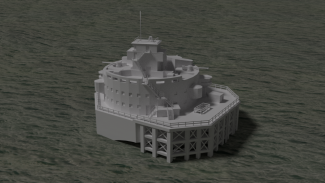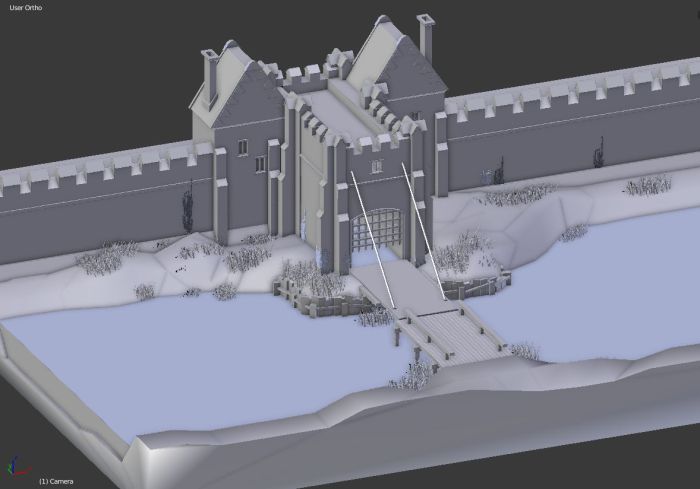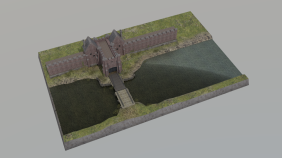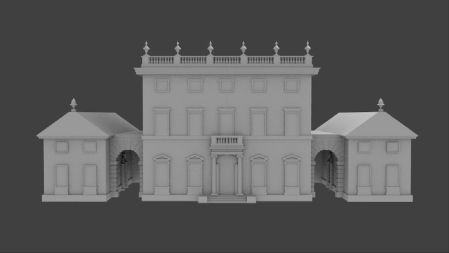Victory in Europe 75th anniversary- The 8th-10th May 2020 is a time to reflect and commemorate the enormous sacrifices made during the Second World War.
Read more on the East Riding Archives blog: Remembering VE Day: 75th Anniversary

Personal blog on Heritage, 3D, Archives, Local History, Outreach & Digital Engagement
Victory in Europe 75th anniversary- The 8th-10th May 2020 is a time to reflect and commemorate the enormous sacrifices made during the Second World War.
Read more on the East Riding Archives blog: Remembering VE Day: 75th Anniversary

Bull Sand Fort is one of my personal favourite architectural gems (which is unusual as I have a leaning towards gothic architecture) and it has a very evocative and mysterious presence in the Humber Estuary. It sits on a sand bank near Spurn Point (see my 3D model of the lighthouse) and the smaller island fort of Haile Sand.

Bull Sand Fort was built during the First World War to protect the ports located further up the estuary and was officially completed in December 1919.
Both of the forts were often under attack from aircraft and submarines. As of 1987 the fort was given Grade II listed status.
This artistic representation of the fort depicts as it was during the period of the Second World War, with the enhanced gun emplacements at roof level.
The fort contained accommodation for a garrison of 200 including sleeping quarters, stores for beer and coal, a kitchen and boiler rooms.
Although not necessarily true to life of the real Humber Estuary, I modelled the water with some level of translucency so the submerged features of the fort can be seen. The structure was modelled using photographs as a reference and the creation of texture UV maps in Adobe Photoshop. Original plans of the fort dating from 1917 can be consulted in the East Riding Archives, archive reference DDX1200/3/2 and are really interesting historical documents.
For a more in-depth history of this fascinating structure please see this informative account from the Island of Hope website.

As an early Christmas present you can now watch some of the presentations from the ‘Discovering Collections Discovering Communities’ conference online- see the full selection here http://dcdcconference.com/dcdc17-papers/
DCDC17 was held at The Lowry in Salford on the 27th-29th November 2017. My thanks go to the conference hosts, The National Archives and Research Libraries UK, for such an inspiring event. It was a great privilege to present alongside experts in their fields on the big Lowry stage from the archive, library, museums and academic sectors.
My talk (see video above) ‘Archives in 3D: A multidisciplinary approach to digital engagement’ focused on a series of DIY 3D modelling workshops inspired by our collections at the East Riding Archives. Presenting in my work capacity as an Archives Assistant, I spoke about workshop delivery and the practicalities and impact of combining archives with 3D. The workshops were a great opportunity to take part in the Hull City of Culture year. Two of the workshops were official Hull City of Culture events where we focused on recreating the lost, built heritage of Hull as a method of educating and engaging audiences with their local heritage using a creative medium.
I’m really excited to be presenting at this year’s ‘Discovering Collections, Discovering Communities‘ (DCDC) conference. This year’s theme looks at the cultural value of collections and the creative economy, covering topics such as:
I will be speaking within my capacity as Archives Assistant with the East Riding Archives to talk about our Archives in 3D workshops.
Here’s my synopsis for ‘Archives in 3D: A multidisciplinary approach to digital engagement’ :
In celebration of Hull City of Culture 2017, ‘Archives in 3D’ were a series of practical 3D modelling workshops at the East Riding Archives combining digital techniques, interpretation skills, architectural history and the creative reuse of collections. These workshops were an opportunity for participants to recreate Hull and East Riding built heritage whilst learning how to use collections to inspire and inform their own historical reconstructions. This presentation will explore the lessons learned, practicalities and impact of a multidisciplinary approach to digital engagement.
DCDC17 will be held at The Lowry, Salford from 27-29 Nov 2017 and registration will close on October 31st. You can purchase tickets via the DCDC website. #DCDC17
DCDC is managed by Research Libraries UK and The National Archives.

I recently wrote a guest blog post for Sketchfab on my methods for recreating built heritage using archives, Blender 3D software and some heritage interpretation. Many thanks to the Sketchfab Cultural Heritage Lead Tom Flynn and the team! 🙂
You can read my post on the Cultural Heritage section of Sketchfab: Bringing Built Heritage to (Digital) Life
Last year I was very fortunate to be invited to The National Archives (TNA) in Kew to feature in their Archives Inspire video (above), filmed by the wonderful Magneto Films.
It was a privilege to be filmed alongside the other cast who are all brilliant professionals and it was lovely to revisit TNA after spending a year as one of their Transforming Archives Trainee‘s. The Magneto team were very professional, especially as it was my 1st attempt at being in front of a rather large camera!
Archives Inspire is a four year campaign looking at new ways audiences can experience and use archives- have a look at TNA’s Chief Executive Jeff James’ blog post and the Archives Inspire pages on TNA’s website for more.
Digital is an interesting challenge for the archives sector, where records being produced are increasingly in the digital format (think from large organisation’s records to personal photographs). Over the past decade Archivists have been thinking about how to preserve digital media for accountability, evidential, cultural and research purposes. At present, digital is now becoming central to the archival profession as we hope to preserve these records and facilitate access.
I am particularly interested in the creative uses of archives, especially heritage engagement using 3D models, websites, online exhibitions and videogames. I was very honoured to be able to showcase some of my 3D work in TNA’s Archives Inspire video- you can see my North Bar (Beverley) model in the video showcased using the software Blender 3D. Very grateful that something I’ve been doing for over 5 years is being featured in such an important video.
It has been a Blender-filled Easter weekend where I set myself the challenge to 3D model my own interpretation of Hull’s Beverley Gate in the 17th century- see my first post!
After many hours of tweaking settings, I’m now at the stage where I’m happy enough to share it…


There is always much room for improvement in the modelling process. As an architectural historian my focus is mainly on the building fabric, plan and style but my scenes are devoid from human population for the ‘uncanny valley’ reason. Charles I being refused entry into the city by the Hothams would provide more of a historical context to the scene but it will add many more hours of modelling and research.
The interpretation was created using archival and local studies material held at the East Riding Archives and the Hull History Centre. A publication which provided particularly helpful information was “Beverley gate, the birthplace of the English Civil War” (1990) by David Evans and Bryan Sitch, featuring a line drawing interpretation which this 3D model is mostly based on- including the Dutch architectural influence, gables and structural form of the two guard chambers.



With Hull’s UK City of Culture celebrations nearing in 2017 I thought it would be fitting to digitally recreate one of the city’s most historic landmarks- Beverley Gate.

At present, the gate’s structural remains can be seen at the west end of Whitefriargate, Hull. For years the remains have been a much overlooked heritage asset, however thanks to a public opinion campaign and talks of regeneration the structural remains are now a designated National Monument (see Beverley Gate listing on Historic England) .
Beverley Gate has a fascinating story and is one of high historical significance. On the 23rd April 1642, the gate was the location where Hull’s Governor, John Hotham, and his son (also named John Hotham) refused Charles I entry into the city- as a result being one of the catalystic moments of the English Civil War (and the subsequent executions of the Hotham father and son). It is a well-known story and gives the site national importance.
Using Blender, my latest visualisation of Beverley Gate will be based on both artist impressions, archival and secondary source material, held at the Hull History Centre, Hull Museums and the East Riding Archives. I’m aiming to digitally model the gate as it was in 1642- this means it will be a complete architectural structure and not the romanticised version which you can see in George Arnald’s lovely painting “Charles I Demanding Entrance at the Beverley Gate, Hull“, c1819- though I’d love to model this version too!
So far I have modelled the main gate structure, drawbridge and surrounding landscape. The next step will be texturing, finishing touches and hopefully being able to upload the model onto my Sketchfab account- more posts to follow!
For those interested in learning (from scratch!) how to 3D model historical buildings from architectural plans:


As the Hotham house in Beverley, East Yorkshire was demolished over 200 years ago I thought I would carry out some 3D visualisation work on what the building may have looked like in the 18th Century based on the 1715 architectural design.
You may have heard of Sir John Hotham (1st Baronet), who in 1642 refused Charles I of England entry to Kingston Upon Hull, and as a result, contributing to the beginnings of the English Civil War. Over half a century later a member of his extended family, Charles Hotham (4th Baronet), built a grand classical house down Eastgate in the nearby town of Beverley. It was designed by the renowned Georgian architect Colen Campbell who is credited as the founder of the style.

Hotham purchased and demolished several properties down the East side of Eastgate to build his new home (East Riding Archives DDBC/16/67). Built between 1716-1721, the neo-Palladian house was intended to be a family home yet the house remained empty after Charles’ death in January 1723 and was demolished after 50 years.
Creating the Model in Blender: I modelled the front facade of the Hotham house with as much accuracy to Colen Campbell’s elevation drawing in his published work Vitruvius Britannicus (1715). As with most visualisation works, some interpretation had to be made when thinking about the window styles, doorway and material colour.

Campbell does not make clear which building materials were used. Records show that Hotham purchased local red bricks for the building (Hull University Archives, DDHO/15/4) yet Campbell’s design is absent of brickwork. I decided to texture the facade with a stucco-material as this possibly would have been applied on top of the brick surface. Stucco is also a key characteristic of classical architecture.

The symmetrical nature of neo-Palladian architecture meant that Blender’s mirror modifier tool came in handy, saving a lot of modelling time! It would have been useful if Campbell had drawn side elevations, so to interpret the scale of the side facades I used the accompanying ground plan to model an appropriate measurement based on proportions.


William Burrow’s 1747 map of Beverley shows the Eastgate location of the house fronted by a possible semicircular courtyard. Modelling the surrounding gardens and wider environment would be the next challenge to progress this model. This brings to light new questions relating to what the surrounding 18th-century Beverley landscape looked like, research into the garden design of the house and whether to populate the visualisation with people.
